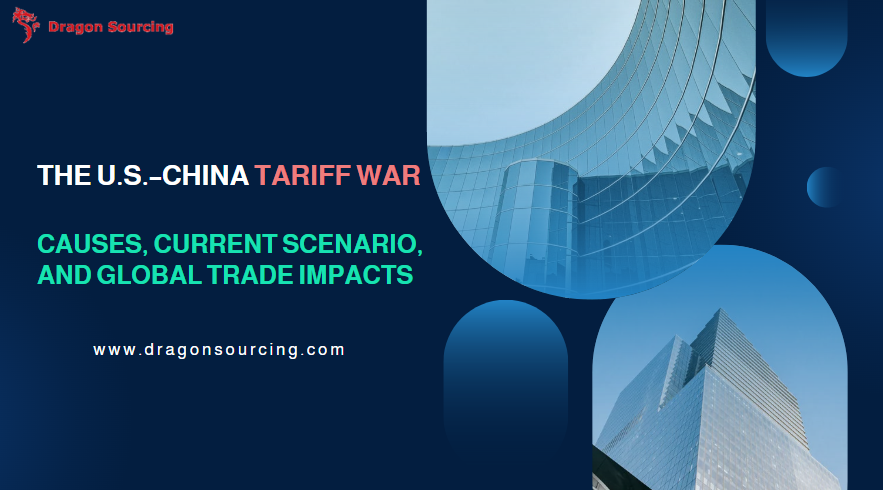
Summary:
-
The U.S.–China trade war reignited in 2025 with steep tariff hikes.
-
U.S. imposed a 10% tariff on all imports and 145% on Chinese goods.
-
China retaliated with up to 125% tariffs and WTO complaints.
-
Global trade growth forecast cut from 3.0% to 0.2% by WTO.
-
Key industries impacted include electronics, agriculture, and retail.
-
Businesses are shifting supply chains to other low-cost countries.
-
Long-term effects include economic slowdown, trade bloc formation, and tech decoupling.
-
Resolution seems unlikely; global trade must adapt to a new reality.
The global economy in 2025 is facing a new wave of uncertainty triggered by renewed trade tensions between the world’s two largest economies: the United States and China. While disputes between these superpowers are not new, the current tariff war escalation is proving to be one of the most disruptive episodes in modern trade history. With sweeping tariff hikes from both sides, businesses, governments, and trade bodies are closely watching how this conflict will reshape the landscape of global commerce.
How It All Started
The U.S.–China trade conflict dates back to 2018, during the administration of President Donald Trump. His administration imposed the first wave of tariffs on Chinese imports, citing issues such as:
-
Persistent trade imbalances
-
Intellectual property theft
-
Forced technology transfers
-
National security concerns
China responded with its own tariffs, setting the stage for a tit-for-tat exchange that disrupted global supply chains. Although the two nations reached a partial truce with the Phase One deal in 2020, underlying tensions remained unresolved. When President Trump returned to office in 2025, the trade conflict quickly reignited and reached unprecedented levels.
What’s Happening Now?
In early 2025, the Trump administration introduced sweeping trade measures, most notably:
-
A 10% universal tariff on all imports into the U.S., excluding Canada and Mexico.
-
Specific tariffs of 60% on Chinese goods, later raised to 145%, a move justified on national security grounds.
These tariffs are part of what Trump has termed “Liberation Day” trade policies, aiming to bring manufacturing back to the U.S. and reduce dependence on China.
China, in retaliation, has:
-
Imposed tariffs up to 125% on U.S. imports.
-
Placed export restrictions on rare earth materials, essential for electronics and defense industries.
-
Filed complaints with the World Trade Organization (WTO), accusing the U.S. of breaching international trade norms.
These policy changes have sparked fears of a deeper, long-term decoupling between the two economic giants.
Impact on Global Trade Today
According to a recent report by the World Trade Organization, the consequences of this tariff war are already being felt:
-
Global trade growth for 2025 has been revised downward from 3.0% to just 0.2%.
-
U.S.–China merchandise trade is expected to shrink by nearly 80% if the current policies persist.
-
Businesses worldwide are dealing with supply chain disruptions, rising costs, and increasing uncertainty.
This economic stand-off is not just about tariffs. It reflects deeper geopolitical issues — including tech competition, military rivalry, and ideological differences — which make resolution more complex than previous trade disputes.
Sectors Hit the Hardest
The impact of these tariffs isn’t uniform. Several industries are bearing the brunt more than others:
-
Electronics and Semiconductors: Components sourced from China are facing heavy duties, increasing costs for U.S. tech companies.
-
Automotive: U.S. carmakers exporting to China face stiff penalties, while also dealing with rising input costs.
-
Agriculture: Chinese tariffs on soybeans, corn, and pork are hurting U.S. farmers who rely heavily on the Chinese market.
-
Apparel and Retail: U.S. consumers are beginning to feel the pinch with rising prices on goods imported from China.
Long-Term Implications
If this tariff war continues, or worsens, several global trends could emerge:
1. Supply Chain Realignment
Companies may continue to diversify away from China, shifting production to other low-cost countries like Vietnam, India, or Mexico. This trend, often called “China Plus One,” had already begun post-COVID and is now accelerating.
2. Nearshoring and Regional Trade Blocs
Firms may favor suppliers closer to home to avoid trade disruptions. We could see the rise of regional trade blocs, with countries forming economic alliances outside of traditional WTO structures.
3. Global Economic Slowdown
A prolonged tariff war could lead to reduced international trade flows, hurting GDP growth in both developing and developed nations. According to the WTO, complete decoupling could slash global GDP by up to 7%.
4. Technological Decoupling
Beyond trade, the U.S. and China are also competing in areas like AI, semiconductors, and clean energy. The current conflict may hasten the splitting of the global tech ecosystem, leading to incompatible standards and platforms.
5. Rise in Protectionism
This conflict may embolden other nations to adopt protectionist policies, further weakening the rules-based global trade order that has governed commerce since World War II.
The Way Forward
Despite the turmoil, there are still opportunities for dialogue. Global trade bodies like the WTO, IMF, and G20 are urging for de-escalation and negotiations. However, with both countries entrenched in their political positions and facing domestic pressures, a quick resolution seems unlikely.
Businesses, therefore, must prepare for a new normal — one where agility, digitalization, and supply chain resilience become key to navigating a fractured trade world.
Conclusion
The escalating tariff war between the U.S. and China is more than just a bilateral dispute — it is a stress test for the entire global trade system. With high tariffs, retaliatory actions, and the threat of economic decoupling, this conflict may reshape international trade for decades to come. While some countries and industries might benefit in the short term, the overall uncertainty is proving to be a drag on global growth and cooperation.
Smart businesses and governments will need to rethink their strategies, focusing on flexibility, diversification, and sustainability to weather the storm.
Sources:


